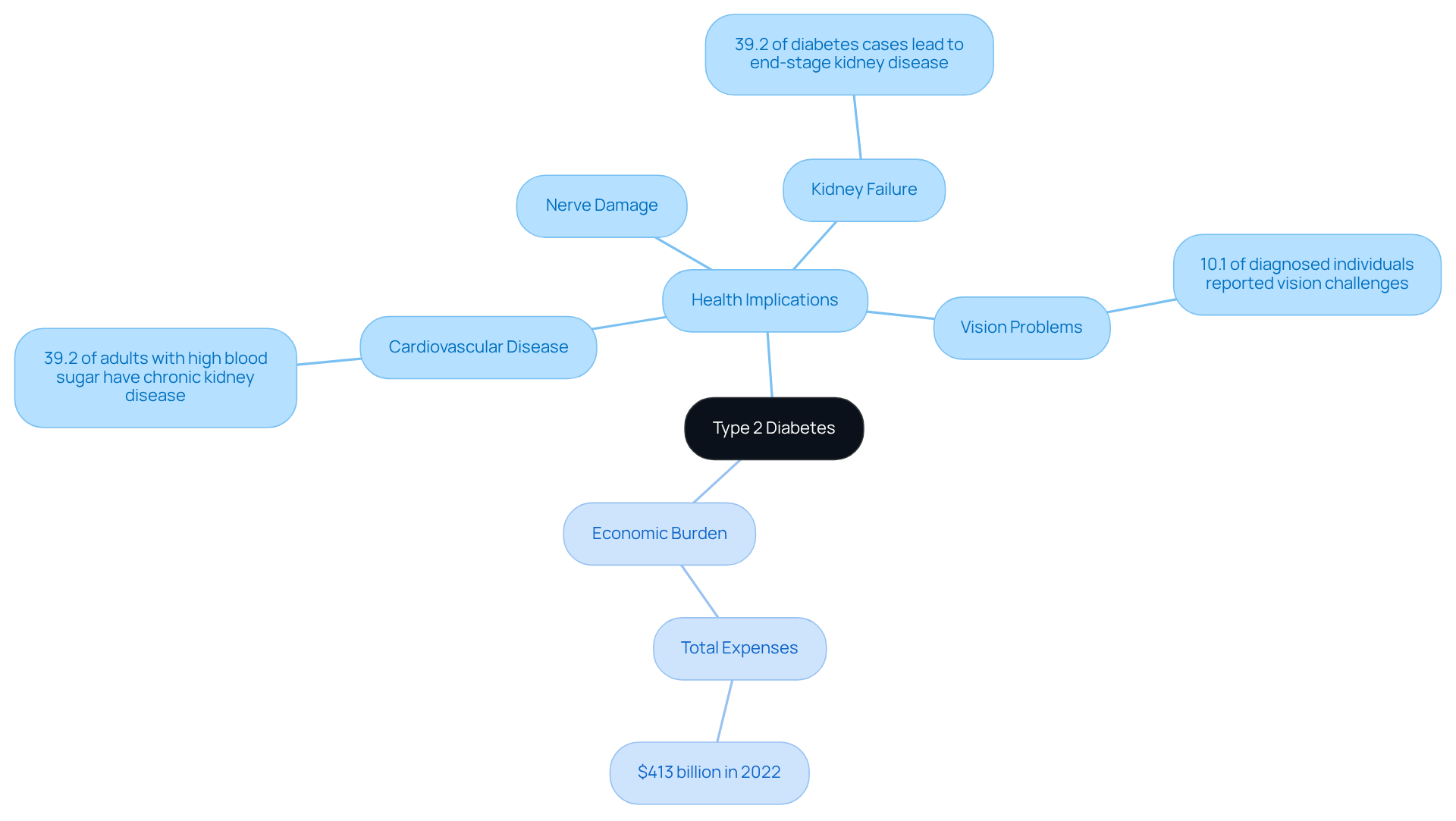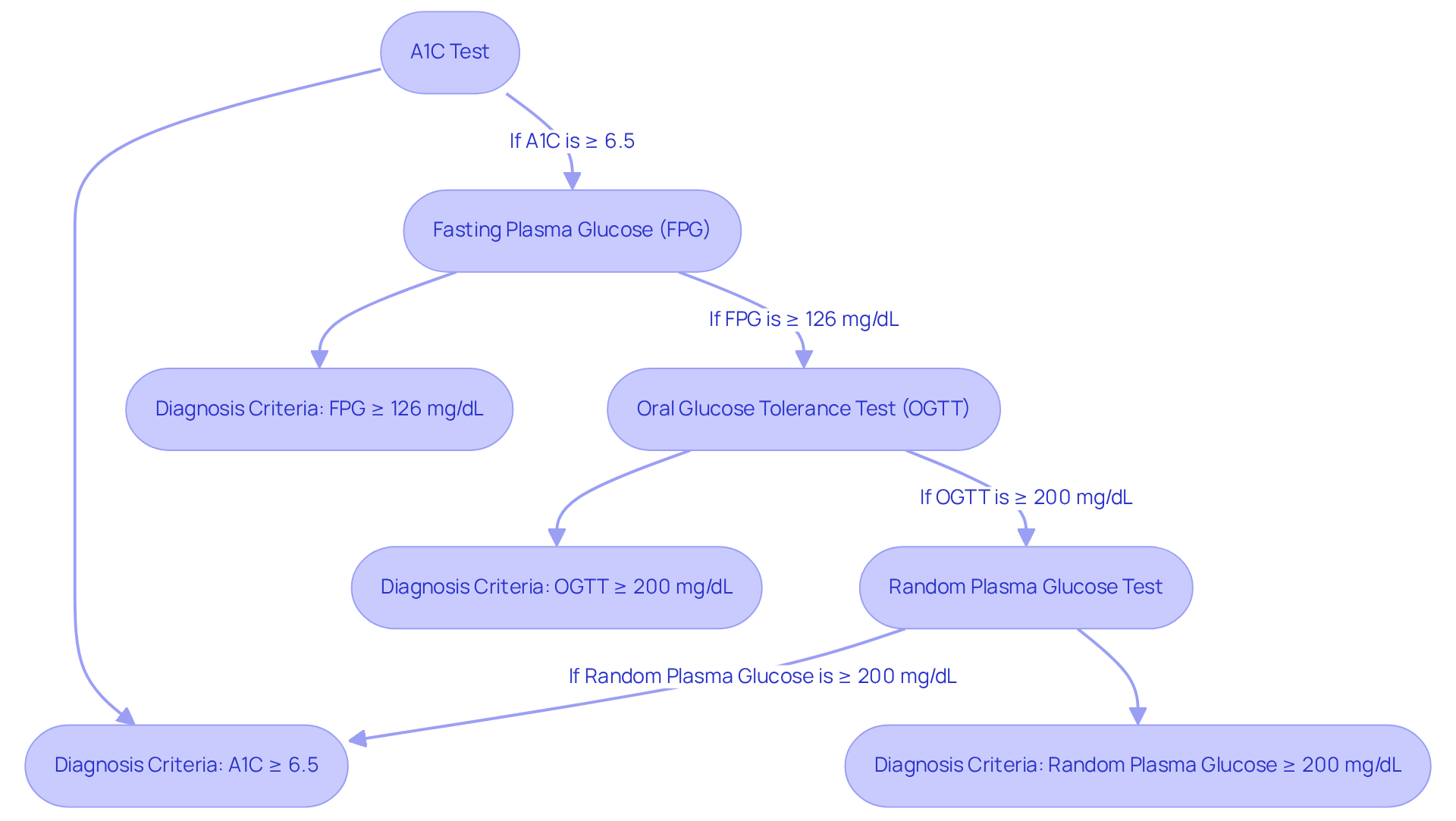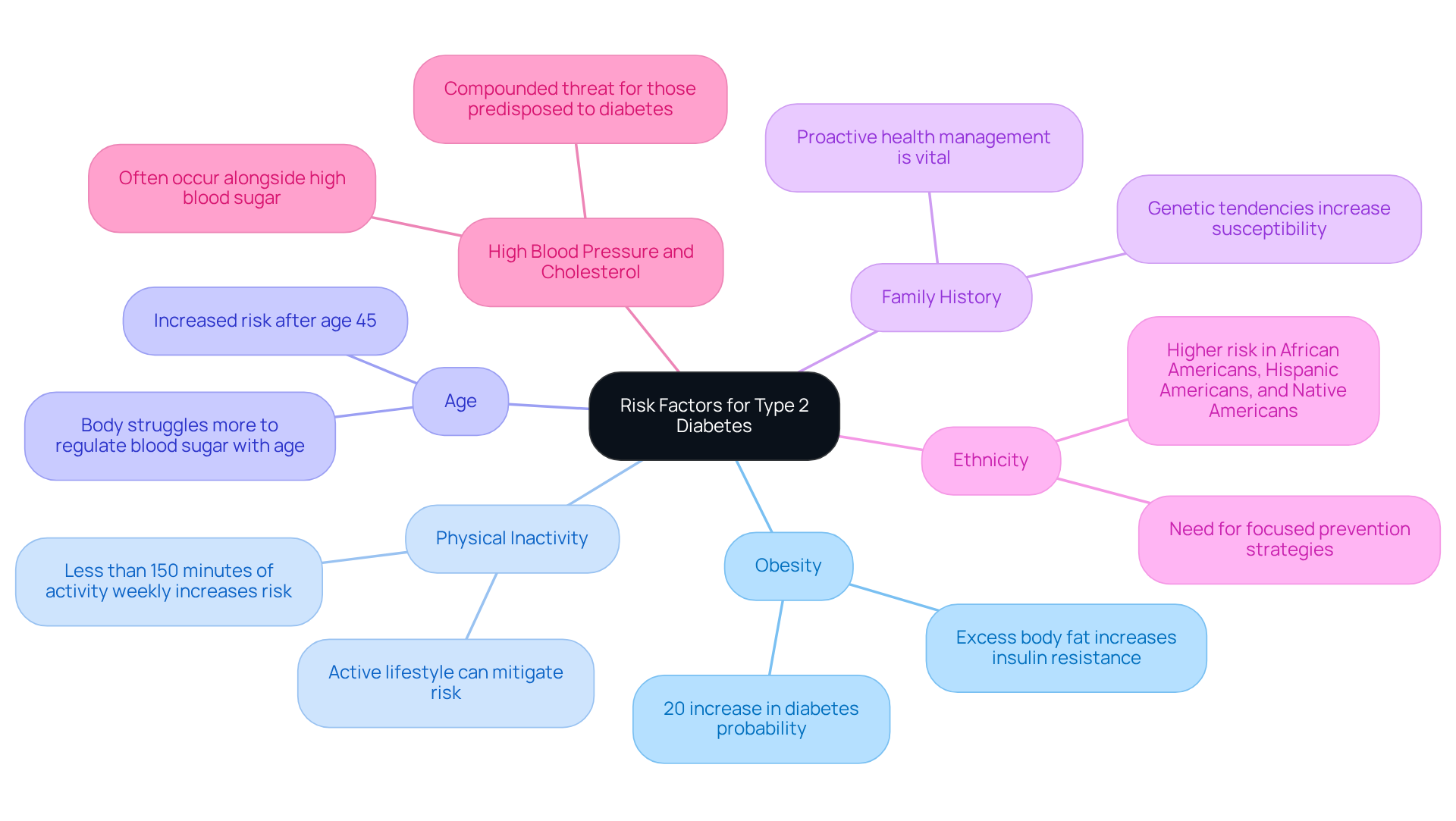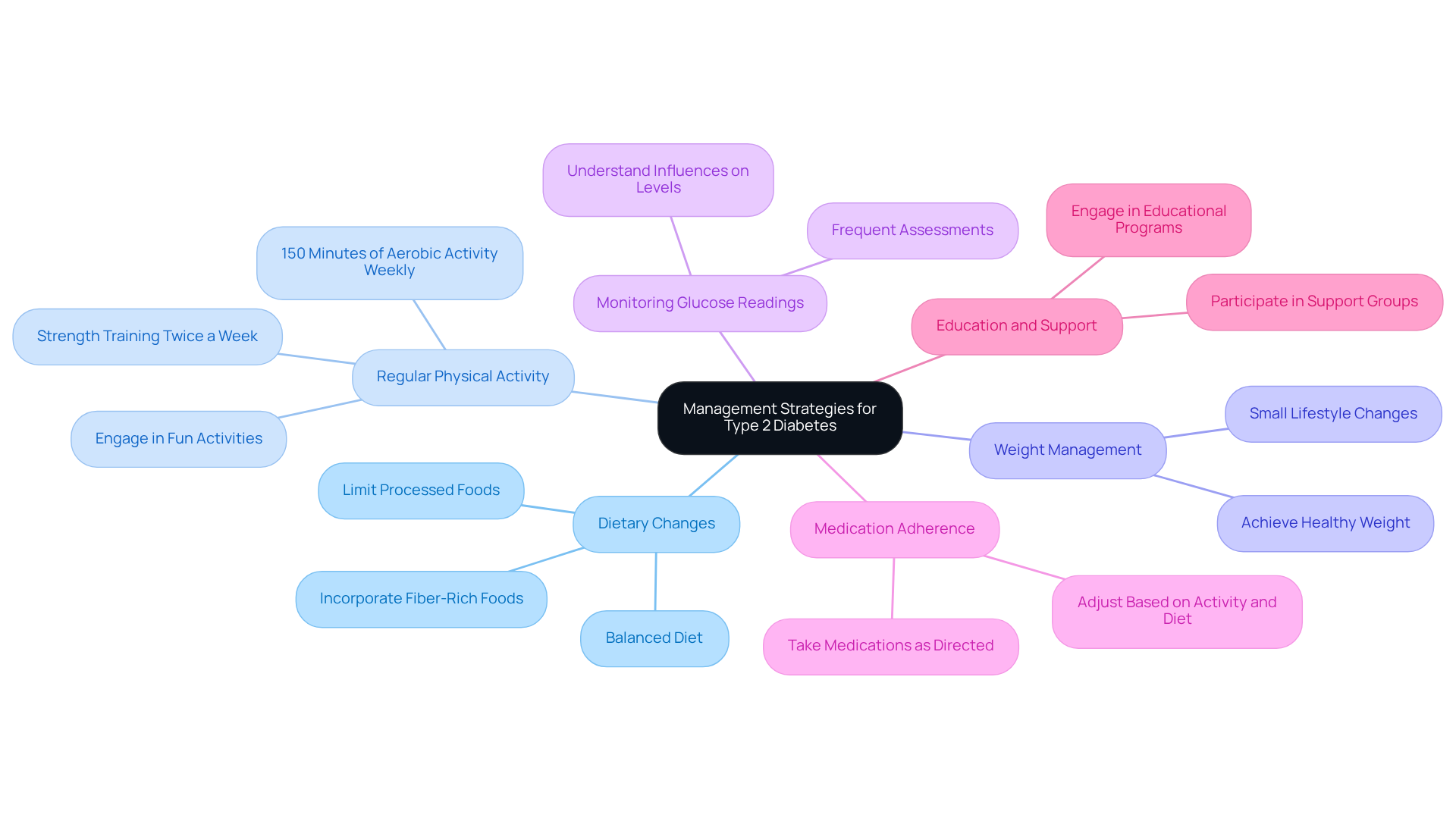Overview
This article is dedicated to understanding the diagnosis of type 2 diabetes, a journey that can often feel overwhelming. We recognize the challenges you may face, and we aim to provide clarity on the key steps involved. It outlines important diagnostic criteria, risk factors, and effective management strategies that can make a significant difference in your health.
It’s essential to understand that a proper diagnosis includes specific tests, such as:
- The A1C test
- The fasting plasma glucose test
These steps are crucial in helping you and your healthcare provider create a tailored approach to your health. Many patients find that knowing their numbers can be empowering, allowing them to take charge of their well-being.
Moreover, lifestyle modifications play a vital role in managing type 2 diabetes. Embracing healthy choices can help mitigate the health risks associated with this condition. Remember, you are not alone in this journey; support is available, and proactive management can lead to a healthier, more fulfilling life.
We encourage you to take action and explore the 30-Day Diabetes Reset program, designed to guide you through this process with compassion and understanding. Together, we can navigate this path toward better health.
Introduction
Understanding the complexities of type 2 diabetes is crucial in a world where its prevalence continues to rise, affecting millions globally. It’s important to recognize that this chronic condition can feel overwhelming for many. This article delves into the essential steps involved in diagnosing type 2 diabetes, offering insights into its implications, risk factors, and management strategies. As you navigate your health journey, you may find yourself asking: How can I effectively take control of my diagnosis and improve my overall well-being in the face of such a pervasive health challenge? Together, we can explore the answers and empower you to make informed decisions for a healthier future.
Define Type 2 Diabetes and Its Implications
A diagnosis for type 2 diabetes indicates a chronic metabolic disorder that affects many individuals, characterized by insulin resistance and elevated blood glucose levels. It’s important to recognize that, unlike type 1 diabetes—where the body fails to produce insulin—those with a diagnosis for type 2 diabetes typically produce insulin but struggle to use it effectively. This dysfunction can lead to serious health complications, including a diagnosis for type 2 diabetes, cardiovascular disease, nerve damage, kidney failure, and vision problems.
Many patients find that this condition is the leading cause of new instances of blindness in adults aged 18-64. In fact, in 2021, 10.1% of diagnosed individuals reported significant vision challenges. Furthermore, cardiovascular health is significantly impacted, as nearly 39.2% of adults with high blood sugar also experience chronic kidney disease. This highlights the interconnectedness of these conditions and the importance of addressing them together.
The economic burden of type 2 diabetes includes substantial costs, with total expenses related to diagnosis for type 2 diabetes reaching approximately $413 billion in 2022. This underscores the critical need for effective management strategies. Understanding these implications is vital for patients. Proactive management can not only mitigate risks but also improve overall health outcomes. Remember, you’re not alone in this journey. Seeking support and guidance can make a significant difference in your path to wellness.
Explore Diagnostic Criteria and Testing Methods
The diagnosis for type 2 diabetes can feel overwhelming, but understanding the process is the first step toward taking control of your health. Several tests are typically involved:
- A1C Test: This test measures your average blood sugar levels over the past 2-3 months. If your A1C is 6.5% or higher, it indicates the presence of diabetes, which can be concerning.
- Fasting Plasma Glucose (FPG): A sample taken after fasting for at least 8 hours. If your concentration is 126 mg/dL (7.0 mmol/L) or greater, it suggests high blood sugar levels.
- Oral Glucose Tolerance Test (OGTT): This test assesses sugar concentrations before and after consuming a sweet beverage. A two-hour glucose measurement of 200 mg/dL (11.1 mmol/L) or more signifies diabetes.
- Random Plasma Glucose Test: A blood sample taken at any time, with a level of 200 mg/dL (11.1 mmol/L) or higher indicating diabetes, especially if you have symptoms.
These tests are crucial for an accurate diagnosis for type 2 diabetes and effective management of your condition. It’s important to recognize that managing type 2 diabetes is a journey, and setting SMART goals—specific, measurable, attainable, relevant, and time-bound—can make a significant difference. For instance, aiming for a daily step count of 10,000 or gradually increasing your exercise duration can enhance your motivation and accountability.
Many patients find that regularly tracking their progress through fitness apps, journals, or pedometers fosters a sense of achievement and allows for necessary adjustments in their health strategies. Dr. Jason Shumard’s method at Integrative Wellness Center emphasizes tailored functional medicine, focusing on uncovering underlying issues and empowering patients to take charge of their well-being. This approach can ultimately assist in reversing the condition, offering hope and a pathway to a healthier future.
Identify Risk Factors and Underlying Causes
Several interconnected risk factors contribute to the development of type 2 diabetes, and it’s essential to recognize how they impact your diagnosis for type 2 diabetes personally. Let’s explore these factors together:
- Obesity: Excess body fat, especially around the abdomen, significantly increases insulin resistance, making it a primary risk factor. Recent findings suggest that obesity is associated with a 20% rise in the probability of developing type 2 diabetes. It’s important to understand how this can impact your health journey.
- Physical Inactivity: A sedentary lifestyle can lead to weight gain and heightened insulin resistance. Did you know that individuals who participate in fewer than 150 minutes of moderate physical activity weekly face a significantly greater likelihood of developing diabetes? In San Marcos, CA, embracing an active outdoor lifestyle can help mitigate this threat. Activities like hiking at Lake San Marcos or strolling the paths at Discovery Lake can improve insulin sensitivity and assist in regulating sugar levels.
- Age: The likelihood of developing type 2 diabetes increases with age, especially after 45. As we grow older, our bodies may struggle more to regulate blood sugar, which is why awareness is crucial.
- Family History: A family background of blood sugar issues can increase susceptibility due to genetic tendencies. If you have relatives affected by diabetes, it’s vital to be proactive in managing your health to facilitate a timely diagnosis for type 2 diabetes.
- Ethnicity: Certain ethnic groups, including African Americans, Hispanic Americans, and Native Americans, experience a greater likelihood of developing type 2 diabetes. This highlights the need for focused prevention strategies within these communities.
- High Blood Pressure and Cholesterol: These conditions often occur alongside high blood sugar and can worsen its effects, creating a compounded threat for those already predisposed to diabetes.
Understanding these elements empowers you to take proactive measures in reducing your exposure to a diagnosis for type 2 diabetes. Adopting healthier lifestyles and engaging in regular physical activity can make a significant difference. It’s also essential to acknowledge that traditional treatments for blood sugar regulation, such as insulin injections, may unintentionally heighten insulin resistance, complicating management efforts. Many patients find that lifestyle modifications, like increased physical activity and better dietary choices, can significantly lower the risk of diabetes-related conditions. This reinforces the importance of education and community support in managing health outcomes.
For customized advice and assistance tailored to your specific needs, consider reaching out to Dr. Jason Shumard at Integrative Wellness Center. Our skilled team is dedicated to helping you navigate your health journey with care and proficiency.
Implement Management Strategies for Effective Control
Managing type 2 diabetes effectively can feel overwhelming, but it’s important to recognize that receiving a diagnosis for type 2 diabetes empowers you to take control of your health. Here are some key strategies to consider:
-
Dietary Changes: Emphasizing a balanced diet rich in whole foods—think vegetables, lean proteins, and whole grains—can make a significant difference. Limiting processed foods and sugars is essential. Many find that incorporating fiber-rich foods not only enhances glycemic control but also contributes to overall well-being.
-
Regular Physical Activity: Aim for at least 150 minutes of moderate-intensity aerobic activity each week. This could be complemented by strength training exercises targeting all major muscle groups on two or more days per week. Engaging in physical activity can enhance sugar regulation and boost your overall well-being. Research shows that consistent aerobic activity can contribute to a better diagnosis for type 2 diabetes by reducing A1C measurements by at least 0.5% in adults.
-
Weight Management: Achieving and maintaining a healthy weight is crucial for enhancing insulin sensitivity and glucose regulation. Small lifestyle changes, like starting with a 10-minute walk after dinner, can lead to significant improvements over time.
-
Monitoring Glucose Readings: Have you ever noticed how your dietary choices and physical activity affect your glucose levels? Frequently assessing your glucose readings can help you understand these influences better. This self-monitoring is vital for making informed decisions about your lifestyle adjustments.
-
Medication Adherence: If medications are prescribed, it’s crucial to take them as directed. Adjustments may be necessary based on your physical activity levels and dietary changes, so staying in tune with your body is key.
-
Education and Support: Engaging in educational programs and support groups focused on managing blood sugar fosters a sense of community and motivation. Many individuals find that interacting with resources, like Dr. Shumard’s educational materials, enhances their understanding of blood sugar management and empowers them to make informed health choices.
By implementing these strategies, you can significantly improve your diabetes control and overall health, which may lead to a timely diagnosis for type 2 diabetes and a better quality of life. Remember, you are not alone on this journey; support is available, and every small step counts.
Conclusion
Understanding the diagnosis of type 2 diabetes is crucial for individuals seeking to take charge of their health. This chronic condition, characterized by insulin resistance and elevated blood glucose levels, can lead to severe complications if left unmanaged. It’s important to recognize that timely diagnosis and effective management strategies can empower you to mitigate risks and improve your overall well-being.
Throughout this article, we’ve shared key insights regarding the diagnostic criteria and testing methods essential for identifying type 2 diabetes. From the A1C test to fasting plasma glucose measurements, these assessments are vital in establishing a diagnosis. Many patients find that knowing the risk factors—such as obesity, physical inactivity, and family history—can significantly enhance their health outcomes. By understanding these elements, you can adopt proactive measures to improve your health.
Ultimately, the journey of managing type 2 diabetes is one of empowerment and education. By implementing effective management strategies—such as dietary changes, regular physical activity, and monitoring glucose levels—you can take significant steps toward controlling your condition and improving your quality of life. Embracing a supportive community and seeking professional guidance can further enhance this journey, reinforcing the importance of understanding and addressing type 2 diabetes for a healthier future. Remember, you are not alone in this journey, and every small step you take brings you closer to a healthier life.
Frequently Asked Questions
What is type 2 diabetes?
Type 2 diabetes is a chronic metabolic disorder characterized by insulin resistance and elevated blood glucose levels. Unlike type 1 diabetes, individuals with type 2 diabetes typically produce insulin but have difficulty using it effectively.
What are the potential health complications associated with type 2 diabetes?
Health complications from type 2 diabetes can include cardiovascular disease, nerve damage, kidney failure, vision problems, and it is a leading cause of new instances of blindness in adults aged 18-64.
How prevalent are vision challenges among individuals diagnosed with type 2 diabetes?
In 2021, 10.1% of diagnosed individuals reported significant vision challenges due to type 2 diabetes.
What percentage of adults with high blood sugar also experience chronic kidney disease?
Nearly 39.2% of adults with high blood sugar also experience chronic kidney disease, highlighting the interconnectedness of these conditions.
What is the economic impact of type 2 diabetes?
The total expenses related to type 2 diabetes reached approximately $413 billion in 2022, indicating a significant economic burden associated with the condition.
Why is proactive management important for individuals with type 2 diabetes?
Proactive management is vital as it can mitigate risks and improve overall health outcomes for individuals with type 2 diabetes. Seeking support and guidance can also significantly aid in the journey to wellness.



